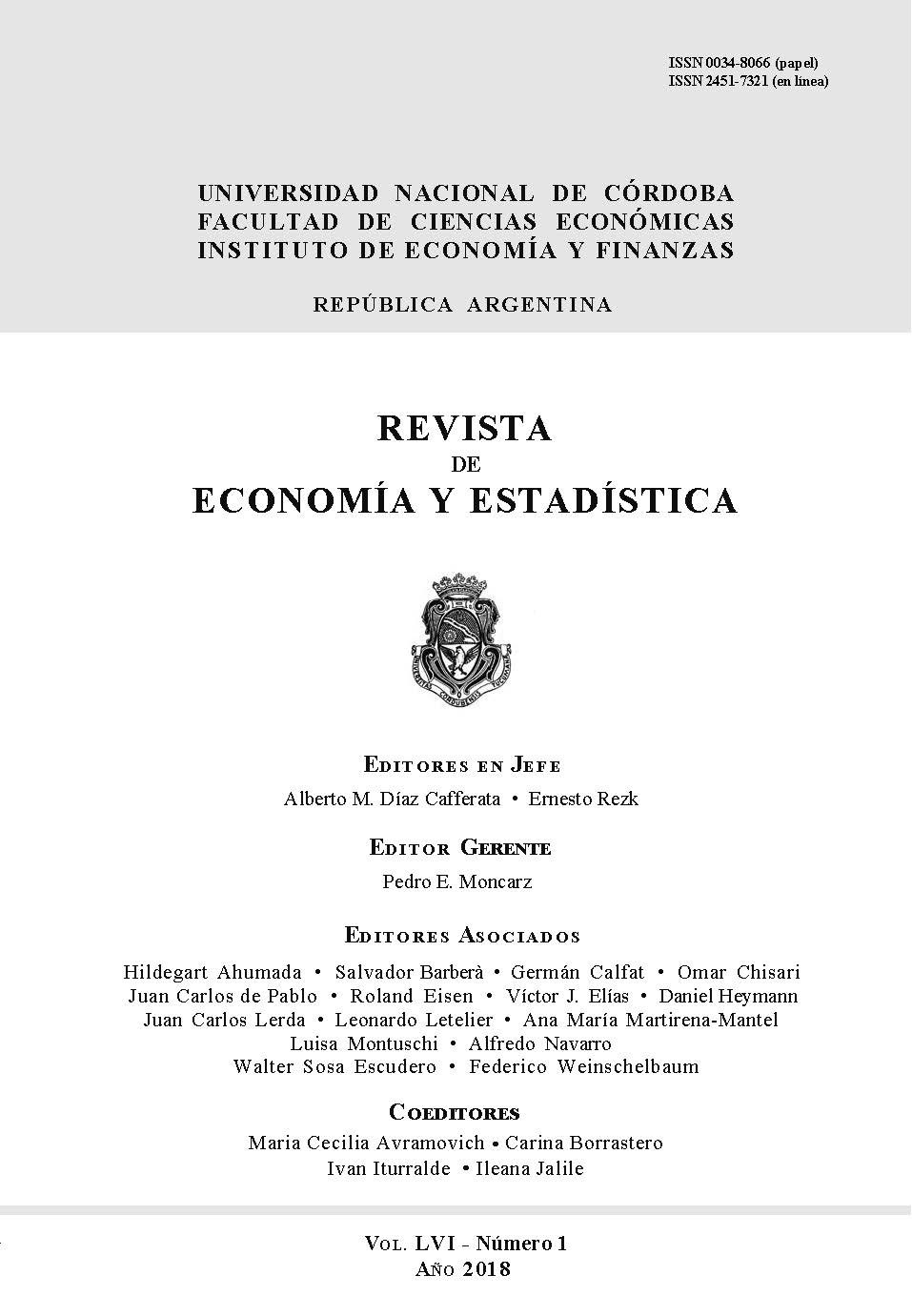Los tipos de cambio reales de la UE: Un VAR bayesiano estructural. Una nota.
DOI:
https://doi.org/10.55444/2451.7321.2018.v56.n1.29387Palabras clave:
competitividad, integración europea, estimación bayesiana, tipos de cambios realesResumen
En este trabajo se contribuye a la larga literatura sobre la determinación del intercambio real mediante la estimación de un modelo autorregresivo del vector estructural bayesiano. Nuestro objetivo es identificar el efecto en la TRE de la UE-28 de los shocks originados en sus principales variables fundamentales, a saber, cuenta corriente, consumos del gobierno, inversión e ingresos reales. Encontramos en la mayoría de las perturbaciones que la TRE se aleja durante largos períodos, lo que demuestra una vez más, que la condición de paridad de poder adquisitivo rara vez se cumple empíricamente.
Descargas
Referencias
Amano, R. A., and S. van Norden. (1995). ‘‘Terms of Trade and Real Exchange Rates: The Canadian Evidence’’. Journal of International Money and Finance 14(1): 83–104.
Amano, R. and S. van Norden. (1998). ‘‘Oil Prices and the Rise and Fall of the US Real Exchange Rate’’. Journal of International Money and Finance 17(2): 299–316.
Benigno, Gianluca, and C. Thoenissen. (2003). ‘‘Equilibrium Exchange Rates and Supply-Side Performance’. The Economic Journal 113(486): C103–24.
Berg, A., and Y. Miao. (2010). ‘‘The Real Exchange Rate and Growth Revisited: The Washington Consensus Strikes Back?’’ IMF Working Papers WP/10/58.
Comunale, M.. (2017). ‘‘Dutch Disease, Real Effective Exchange Rate Misalignments and Their Effect on GDP Growth in EU’’. Journal of International Money and Finance 73: 350–70.
Cuestas, J. C. (2009). ‘‘Purchasing Power Parity in Central and Eastern European Countries: An Analysis of Unit Roots and Nonlinearities’’. Applied Economics Letters 16(1): 87–94.
Cuestas, J. C., Gil-Alana L. A. , and K. Staehr. (2014). ‘‘Government Debt Dynamics and the Global Financial Crisis: Has Anything Changed in the EA12?’’ Economics Letters 124(1): 64–66.
Cunado, J. (2011). ‘‘Structural Breaks and Real Convergence in OPEC Countries’’. Journal of Applied Economics 14(1): 101-117.
Frenkel, J.A, and A. Razin. (1996). Fiscal Policies and Growth in the World Economy, Third Edition. The MIT Press.
Gil-Alana, L. A., N. Luqui, and J. Cunado. (2008). ‘‘Trade Balance and Exchange Rate: Unit Roots, Co-Integration and Long Memory in the US and the UK’’. Economic Notes 37(1): 59–74.
Litterman, R.(1986). ‘‘Forecasting with Bayesian Vector Autoregressions: Five Years of Experience’’. Journal of Business & Economic Statistics 4(1): 25–38.
Neary, P. (1988). ‘‘Determinants of the Equilibrium Real Exchange Rate’’. The American Economic Review 78(1): 210–15.
Obstfeld, M., and K. Rogoff. (1995). ‘‘Exchange Rate Dynamics Redux’’. Journal of Political Economy 103(3): 624–60.
Pesaran, H., and Y. Shin. (1998). ‘‘Generalized Impulse Response Analysis in Linear Multivariate Models’’. Economics Letters 58(1): 17–29.
Sims, C. A. (1988). ‘‘Bayesian Skepticism on Unit Root Econometrics’’. Journal of Economic Dynamics and Control 12(2–3): 463–74.
Taylor, A. M. (2002). ‘‘A Century of Current Account Dynamics’’. Journal of International Money and Finance 21(6): 725–48.
Vieira F., and R. MacDonald. (2012). ‘‘A Panel Data Investigation of Real Exchange Rate Misalignment and Growth’’. Estudos Econômicos, 42(3): 433–56.
Wei, S. and D. Parsley. (1995). ‘‘Purchasing Power Disparity During the Floating Rate Period: Exchange Rate Volatility, Trade Barriers and Other Culprits’’. National Bureau of Economic Research. Working Paper w5032.
Descargas
Publicado
Número
Sección
Licencia
Derechos de autor 2018 Juan Carlos Cuestas

Esta obra está bajo una licencia internacional Creative Commons Atribución-NoComercial-SinDerivadas 4.0.
Aquellos autores/as que tengan publicaciones con esta revista, aceptan los términos siguientes:
Los autores/as conservarán sus derechos de autor y garantizarán a la revista el derecho de primera publicación de su obra, el cuál estará simultáneamente sujeto a la Licencia Creative Commons Atribución-NoComercial-SinDerivar 4.0 Internacional que permite a terceros compartir la obra siempre que se indique su autor y su primera publicación esta revista.
Los autores/as podrán adoptar otros acuerdos de licencia no exclusiva de distribución de la versión de la obra publicada (p. ej.: depositarla en un archivo telemático institucional o publicarla en un volumen monográfico) siempre que se indique la publicación inicial en esta revista.
Se permite y recomienda a los autores/as difundir su obra a través de Internet (p. ej.: en archivos telemáticos institucionales o en su página web) antes y durante el proceso de envío, lo cual puede producir intercambios interesantes y aumentar las citas de la obra publicada. (Véase El efecto del acceso abierto)










